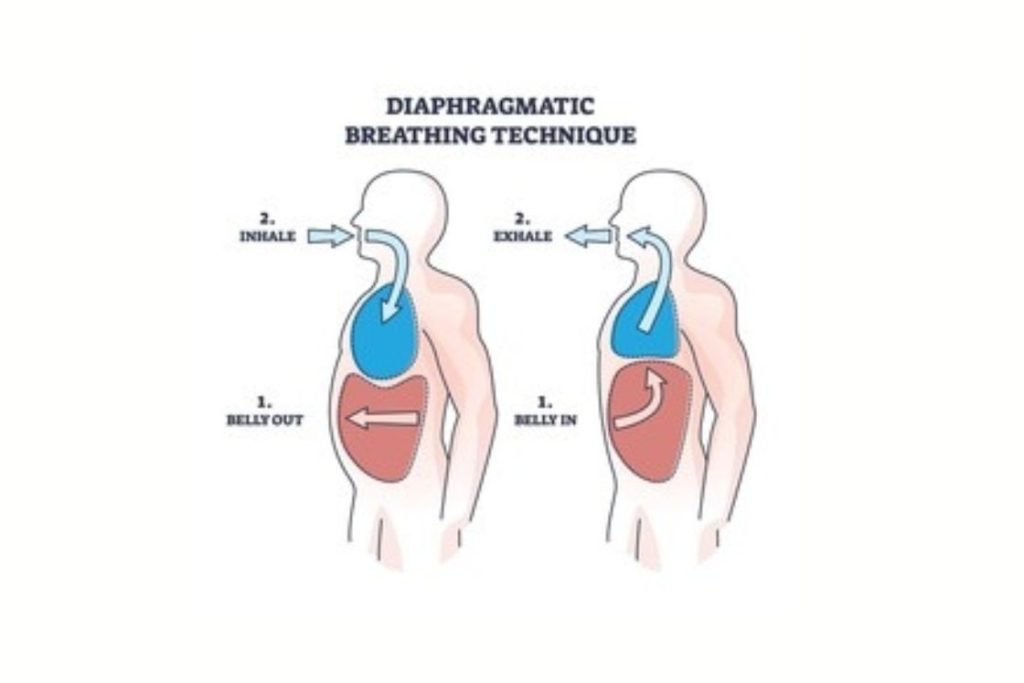
In the hustle of our daily lives, one thing often slips our notice – the breath. It’s an automatic rhythm, a constant companion. But what if I told you that the simple act of breathing could be a key to unlocking your goals and aspirations? Welcome to the world of breathwork, a practice that goes beyond the inhale and exhale to connect with the very essence of our being.
Imagine a tool that not only helps you relax but also propels you towards your dreams. This article is your guide into the science behind how the way we breathe influences our minds and emotions, and ultimately shapes our path to success. So, let’s take a deep breath together and embark on a journey into the profound connection between breath, mind, and the achievement of your goals.
What is Breathwork?
Breathwork is not just about inhaling and exhaling; it’s a deliberate and conscious practice that taps into the power of breath to influence our mental and emotional well-being.
In essence, breathwork is the intentional use of breath to achieve specific outcomes; physical, mental or emotional. To understand its impact, let’s delve into the physiology of breath – exploring how the intricate dance between oxygen and our body systems plays a pivotal role in shaping our mental states.
Physiology of Breath
When we breathe, the air we inhale isn’t just a mechanical process; it initiates a complex and vital dance within our bodies.
Here’s a closer look at intricate physiological journey of our breath:
- Inhalation:
- Air’s Journey: As you breathe in, air enters through your nostrils and travels down your windpipe.
- Lung Expansion: The air reaches your lungs, causing them to expand.
- Oxygen Exchange: In the lungs, oxygen from the air is transferred to tiny blood vessels called capillaries.
- Blood and Oxygen Bond:
- Hemoglobin Connection: Oxygen binds to hemoglobin, a protein in your red blood cells.
- Transportation: Laden with oxygen, blood journeys through your arteries, circulating to every part of your body.
- Cellular Vitality:
- Delivery to Cells: Blood reaches tiny capillaries near cells, releasing oxygen to fuel cellular functions.
- Waste Collection: Simultaneously, blood collects carbon dioxide, a waste product, to be expelled during exhalation.
This physiological understanding forms the foundation for appreciating the profound impact of breathwork on various aspects of our well-being:
- Cognitive Processes: Oxygen is a crucial fuel for the brain. By optimizing the intake of oxygen through intentional breathing, we enhance cognitive functions, including focus, concentration, and mental clarity.
- Emotions: The physiological link between breath and the release of neurotransmitters influences our emotional states. Breathwork can modulate this connection, contributing to emotional balance, stress reduction, and an improved overall mood.
- Overall Health: Since every cell relies on oxygen for energy production, efficient breathing plays a role in maintaining the vitality of our body systems. Breathwork becomes a dynamic tool for promoting general health and well-being.
In essence, understanding the dance of oxygen within our body sheds light on how conscious and intentional breathwork can influence not only our physiological processes but also our mental and emotional states.
Types of Breathwork
Breathwork comes in various forms, each with its unique approach and benefits. From the simplicity of diaphragmatic breathing to the ancient wisdom of pranayama and the profound experiences of holotropic breathwork, there are different types of breathwork practices:
Diaphragmatic Breathing: The Foundation of Calm

Begin with the basics – diaphragmatic breathing. This technique focuses on engaging the diaphragm for a deep, slow inhalation and complete exhalation. By doing so, it activates the body’s relaxation response, promoting a sense of calm and reducing stress.
Pranayama: Yoga Breathing Exercises
Explore the rich tradition of pranayama, originating from ancient yogic practices. Pranayama involves various controlled breathing exercises that go beyond simple inhalation and exhalation. These techniques aim to balance and harness the life force energy, or “prana,” within the body, promoting mental clarity, emotional balance, and overall well-being.
Holotropic Breathwork
For those seeking a more transformative experience, holotropic breathwork offers a unique approach. Developed by Dr. Stanislav Grof, this technique involves deep, rhythmic breathing to induce altered states of consciousness. It’s a method that goes beyond conventional boundaries, providing a pathway for self-discovery, emotional release, and spiritual exploration.
Box Breathing: Precision in Every Breath

In situations where focus and composure are paramount, box breathing provides a structured approach. Also known as square breathing, it involves inhaling, holding the breath, exhaling, and pausing in a rhythmic pattern, helping to regulate the nervous system, improve concentration, and reduce anxiety.
Mindful Breathing: Present in Every Moment
While not a specific technique, mindfulness in breathing deserves mention. Mindful breathing is simply being fully present in each breath can have profound effects on stress reduction and mental clarity. This accessible practice encourages individuals to observe their breath without judgment, fostering a heightened awareness of the present moment.
Benefits of Breathwork
Breathwork which encompasses intentional techniques like slow breathing and deep diaphragmatic, offers a range of benefits for both mind and body.
Scientific studies indicate that breath work practices can lead to increased comfort, relaxation, and mental alertness, while simultaneously reducing symptoms of stress, anxiety, and depression. Breathwork has been linked to improved attention, emotional well-being, and regulation of cortisol levels, a hormone associated with stress.
Additionally, the practice has shown promise in reducing physiological stress, especially in older adults. Beyond these physiological benefits, breathwork fosters emotional balance, enhances mental clarity, and boosts energy levels by optimizing oxygen intake.
1. Stress Reduction
Stress, the silent adversary to our well-being, can impede our journey towards achieving goals. Breathwork serves as a powerful ally in reducing stress by engaging the body’s relaxation response. As you consciously regulate your breath, the nervous system shifts, signaling the body to release tension and promoting a sense of calm.
By alleviating stress, breathwork becomes a vital tool for maintaining the mental resilience necessary to navigate challenges on the path to your goals.
2. Emotional Regulation
Our emotions play a significant role in shaping our decisions and actions. Breathwork contributes to emotional balance by fostering a connection between the breath and the emotional centers of the brain. Through intentional breathing, individuals can regulate emotional responses, enhance emotional intelligence, and build resilience. This emotional harmony lays a stable foundation for navigating the inevitable highs and lows on the journey toward achieving personal goals.
3. Clarity of Mind
In the chaos of daily life, achieving mental clarity is akin to finding a guiding light. Breathwork acts as this beacon by enhancing focus and mental clarity. By engaging in regulated breathing practices, you create a space for mindfulness, allowing you to set aside distractions and honing your ability to concentrate. This heightened focus becomes a valuable asset in effective goal setting, enabling you to delineate clear objectives and devise strategic plans for achievement.
4. Improved Energy Levels
Every cell in our body relies on oxygen for energy production. Proper breathing, facilitated by breathwork practices, optimizes oxygen intake, thereby fueling physical and mental vitality. The increased oxygenation of tissues and organs supports overall health, fostering a sense of vigor and alertness. By addressing the very source of energy within the body, breathwork becomes a foundational element for sustaining the momentum needed to pursue and attain your goals.
How Breathwork Supports Goal Achievement?

Breathwork practices play a pivotal role in achieving goals and manifestation. Controlled breathing fosters a focused and calm mindset, enhancing effective goal setting. When coupled with visualization, breathwork intensifies goal clarity, embedding aspirations into the subconscious.
Aligning breath with intentionality directs energy towards specific objectives, while positive affirmations reinforce a positive mindset crucial for success. Mindfulness in breathwork aids strategic decision-making on the path to achievement.
By integrating breathwork into goal-setting routines, individuals cultivate mental and emotional resilience, creating an internal environment conducive to manifesting their envisioned success.
Breathwork Practices for Goal Achievement
Engaging in intentional breathwork practices offers a transformative approach to pursuing and realizing personal goals.
Visualization techniques, when coupled with controlled breathing, enhance goal clarity and deeply embed aspirations. Setting intentions with conscious breath aligns energies towards specific objectives, fostering a purpose-driven mindset. Positive affirmations, seamlessly integrated into breathwork, fortify a positive belief system crucial for success. Mindfulness, a core aspect of breathwork, sharpens focus and aids strategic decision-making on the path to achievement.
By weaving these breathwork practices into daily goal-setting routines, individuals cultivate a resilient internal environment, propelling them toward the manifestation of their envisioned success.
Visualization Techniques

Engaging in intentional breathwork alongside visualization exercises amplifies the impact of both practices. By combining controlled breathing with vivid mental imagery, individuals create a potent synergy. This synergy not only enhances the clarity of envisioned goals but also imprints them deeply into the subconscious mind.
Setting Intentions
Breathwork becomes a powerful companion in the process of setting clear intentions. By consciously aligning breath with the articulation of goals, individuals create a focused and intentional mindset. This alignment serves as a guiding force, directing energies towards specific objectives and fostering a sense of purpose.
Positive Affirmations

The incorporation of positive affirmations into breathwork practices reinforces a positive mindset. By synchronizing intentional breath with affirmations, individuals cultivate a harmonious internal dialogue. This positive self-talk, ingrained during breathwork sessions, becomes a resilient mental foundation, fortifying the belief in one’s ability to achieve set goals.
Mindfulness and Presence
The essence of breathwork lies in fostering mindfulness and presence. These qualities are paramount in effective goal setting. By engaging in breathwork practices that promote mindful awareness, individuals learn to stay present in each moment. This heightened awareness becomes a key asset in navigating challenges and making strategic decisions on the path to goal achievement.
breathwork to focus on your goals
Delve into targeted breathwork practices designed to foster goal achievement and enhance your overall well-being.
Start with simple breathwork practice called box breathing. The rhythmic precision of box breathing provides a structured approach, promoting focus and emotional balance. Alternatively, the ancient wisdom embedded in alternate nostril breathing (Nadi Shodhana) offers a unique pathway to heightened vitality and emotional equilibrium.
Box Breathing
This structured breathing technique acts as a powerful tool to instill concentration and calmness, laying a foundation for goal-oriented success. By introducing the simple yet effective steps of box breathing, we embark on a journey to unlock its potential in promoting mental clarity and resilience, crucial elements in navigating the path towards achieving your aspirations.
Follow these simple steps to practice box breathing for mental clarity and resilience:
- Inhale (4 counts): Begin by taking a slow, deliberate breath for a count of four, filling your lungs completely.
- Hold (4 counts): Pause at the top of your inhalation, holding your breath for a count of four. This moment of stillness cultivates concentration and mental clarity.
- Exhale (4 counts): Release your breath gradually and completely over a count of four, expelling tension and promoting relaxation.
- Pause (4 counts): At the bottom of your exhale, maintain a brief pause for another count of four. Embrace this moment of calm before the next inhalation.
Application in goal-oriented situations involves integrating these steps during moments of heightened stress or when focus is paramount. By incorporating box breathing, you create a mental space conducive to strategic thinking and empowered decision-making, aligning your breath with the pursuit of your goals.
Alternate Nostril Breathing (Nadi Shodhana)
Nadi Shodhana, or alternate nostril breathing, is a centuries-old yogic practice designed to restore balance and enhance mental clarity.
Here’s a simple guide to the technique and its profound impact on goal-oriented focus:
- Posture: Sit comfortably with your spine straight, shoulders relaxed. Use your right thumb to close your right nostril and your right ring finger to close your left nostril.
- Inhalation: Begin by inhaling deeply through your left nostril, closing the right nostril with your thumb.
- Hold and Switch: After a full inhalation, close the left nostril with your ring finger, release the right nostril, and exhale completely.
- Repeat: Inhale through the right nostril, close it, release the left nostril, and exhale. This completes one cycle. Repeat for several rounds.
The impact of Nadi Shodhana on balancing the mind is profound. By alternating the breath through each nostril, this practice harmonizes the left and right hemispheres of the brain, promoting a sense of balance and focus. The result is enhanced mental clarity, an essential state for effective goal setting and strategic decision-making. As we delve into the technique, discover how Nadi Shodhana becomes a valuable companion on the journey toward achieving your goals.
Holotropic Breathwork
Holotropic breathwork often involves accelerated breathing, pushing the boundaries of conventional rhythms. This intense approach is thought to induce altered states of consciousness, opening doors to self-discovery and transformation.
The experience is heightened through carefully chosen music and sensory stimuli. The synergy of breath, sound, and sensation creates a unique environment for deep introspection, expanding the boundaries of self-awareness.
This breathwork practice aims to release repressed emotions and delve into the subconscious. By exploring unconventional breathing patterns, individuals may access profound emotional layers, promoting emotional healing and self-understanding.
Post-session, participants engage in activities like drawing, journaling, or group sharing to integrate their experiences. This crucial step aids in making sense of the insights gained during the breathwork journey.
Tips to Get Started with Breathwork

Consider these practical tips as you begin your exploration to breathwork:
- Start Slowly: Begin with simple techniques like diaphragmatic breathing before advancing to more complex practices. Establishing a foundation allows for a smoother transition into the breathwork experience.
- Consistency Matters: Incorporate breathwork into your routine consistently. Even a few minutes each day can yield cumulative benefits over time. Consistency is key to unlocking the full potential of breathwork.
- Create a Comfortable Space: Find a quiet and comfortable space for your breathwork practice. Minimize distractions and create an environment conducive to relaxation and focus.
- Explore Different Techniques: Experiment with various breathwork techniques to discover what resonates with you. From box breathing to alternate nostril breathing, each method offers unique benefits. Find the one that aligns with your goals and preferences.
- Mindful Awareness: Embrace mindful awareness during your breathwork sessions. Focus on the sensations of each breath, observe your thoughts without judgment, and cultivate a present-moment awareness.
- Guided Sessions: Consider joining guided breathwork sessions, either in-person or through digital platforms. Experienced instructors can provide valuable guidance, ensuring a safe and effective breathwork experience.
- Listen to Your Body: Pay attention to how your body responds during and after breathwork. If you experience discomfort or dizziness, slow down or pause. Listen to your body’s cues and adjust your practice accordingly.
- Integration Time: Allow time for integration after your breathwork session. Reflect on your experiences, jot down insights, or engage in calming activities. Integration enhances the overall impact of your practice.
Remember, breathwork is a personal journey, and there’s no one-size-fits-all approach. These tips serve as a compass, guiding you as you embark on your breathwork adventure for enhanced well-being and goal clarity.
Conclusion
Breathwork is the practice of intentional breathing. We can use the practice of breathwork for mental clarity which eventually can help us achieving our goals. Techniques like box breathing and alternate nostril breathing offer benefits such as increased focus and emotional balance. Holotropic breathwork takes us on a transformative journey, unlocking profound self-discovery.
By embracing these practices, we tap into the potential of our breath to guide us toward our aspirations with a clearer mind and renewed energy. Remember, the simple act of breathing can be a key to unlocking a path to your goals.




